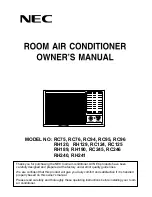
4
4. GENERAL INFORMATION
The 6633 series package air conditioners are intended only for
installation by home manufacturers. The units are for “off the
roof” installations and will usually be installed under a floor. It
is understood that the home manufacturer has provided an
installation area which allows for floor cutouts and unit
mounting without cutting vital frame members or electrical
wiring and that structural members in the installation area will
not create restrictions by passing through airways required by
the air conditioner.
Conditioned air is delivered from the air conditioner to the
interior of the vehicle through ducting that is supplied and
installed by the home manufacturer. The system return air
duct, return air filter and filter retainer are also supplied by the
home manufacturer.
The air conditioner is powered by a 115 volt 20 AMP electrical
service.
5. MOUNTING AND DUCTING CONSIDERATIONS
This unit may be mounted and ducted in any of three ways as
described in the following text. Any mount method selected
must allow for unrestricted air flow to and from the condenser
coil. With perimeter mount systems, the condenser coil and
wirebox access must be facing outboard (See Figure 1 & 2).
Baffling, when inset from home perimeter, must minimize the
degree of recirculation of condenser air which will result in
reduced system performance.
Important:
It is the
responsibility of the installer to provide a furnace damper to
prevent cold conditioned air from passing over the furnace
heat exchanger. Automatic mechanical dampers are available
for this purpose. Chilling the furnace heat exchanger during
the cooling season can result in the formation of condensate
inside the heat exchanger which will promote corrosion and
early heat exchanger failure.
The usual mounting and ducting schemes are described (See
Figure 1 & 2).
1)
Underslung, flush with home perimeter
2)
Underslung, inset from home perimeter
3)
Pad mounted, flush with home perimeter
a)
It is recommended that isolation means, such
as foam, rubberized cords or springs be used
to isolate the unit from direct contact with
the home underbody. This will minimize
vibration transmission into the home.
b)
A duct adaptor kit #6633-6151 consists of 4
10" diameter sheet metal starting collars. The
pre-mounted collar mounts as shown in
Figure 1 & 2 to the end of the unit after
removal and discard of the end shipping
plate and attached styrofoam block.
Do not
remove the top shipping plate when using
the end outlet.
The shipping plates and
styrofoam blocks allow selection of top or
end conditioned air discharge. The blower
system will not allow for top and end
discharge simultaneously. When removing
the shipping plate, take note of the
instruction sticker on the plate.
Remove only the screws indicated on the
sticker. This will allow for easy removal of
the styrofoam block with the plate. Notice
that all screws removed must be re-installed
and one or more screws will be used as
mounting means for the square adaptor plate
along with additional holes already
provided.
Caution:
Do not drill any holes
into the cabinet as they might contact live
electrical parts or high pressure refrigerant
containing components.
c)
The tabbed collar will attach to the unit
return air round opening without extra
fasteners. After installation of any duct
adaptor,
tape all seams of the adaptor
to
minimize air leaks.
d)
A “kazoo-tube” check valve device is
shipped in the wirebox along with a barbed
splice adaptor. If electing to drain the unit
condensate directly, insert the kazoo-tube
assembly into the rubber grommet found in
the end of the unit. The kazoo-tube will
allow condensate drainage and prevent
infiltration of air, odors, insects, etc. If
electing to drain the condensate at a remote
location, attach the barbed splice adaptor to
the unit and insert the kazoo-tube adaptor
assembly at the hose end. A 5/8" dia.
garden hose or equivalent may be used as a
remote drain line. The hose must not rise to
a level higher than the unit outlet for proper
draining. Condensate piping that does not
utilize the kazoo-tube must be constructed






























